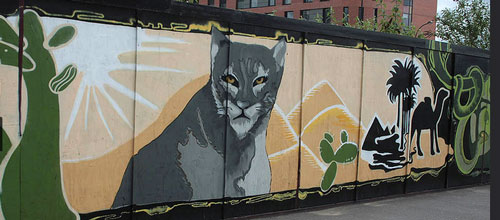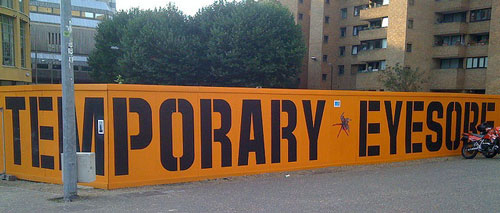Hoarding art
“A lot of people
don’t go to galleries, but it’s important to
expose them to art.”
—Kristyn Wong-Tam
The WORKSIGHT project aims to improve the looks of
hoarding, the
plywood boards placed around work sites, and to give work to local
artists by "encouraging" the developers to buy art work to install
around their construction sites.
At an event to announce the
WORKSIGHT project at City Hall, Ward 27 Toronto
Centre-Rosedale Councillor Kristyn Wong-Tam noted similar projects have
already taken place in the downtown core. At Allan Gardens, hoarding
around an ongoing waterworks project was turned into a First
Nations-themed mural.
Wong-Tam wants
developers and construction
companies to hire local artists to paint murals on their hoardings. The
ideas is that along with beautifying the sites, the artwork can help
local artists.

Hoarding that was on
Avenue Road north Bloor Street
Along with the councillor, the social enterprise group PATCH
Project and an agency Wysp Social Marketing are also involved.
PATCH
Public Art
Through Construction Hoarding
(PATCH), is a group of urban planners, architects and
professional
artists who have teamed up to support urban development and manage
public art projects in the city.

A sample of hoarding
art.
Another area where WORKSIGHT has put its plan into
action is in the Alexandra Park area of Toronto. There, residents
worked together on an art plan for the future hoarding
to surround a massive redevelopment plan in the area. They came up with
designs specific to the community.
PATCH project director Mojan Jianfar stated similar
projects exist in cities like London and New York. While some
construction companies might consider the hoarding a space on which
they can advertise their projects, she said most sites have plenty of
room for both corporate branding and art.

“You could have a percentage
that goes to ads and a percentage that goes to art,” she said during
the Feb. 26 event. “It’s a blank canvas, so each developer could decide
what those portions are and what percentage goes to public art.”
A group of young Alexandra Park
residents spent months working on art that will go up on construction
hoarding as that community undergoes a massive redevelopment. They came
up with two designs that capture the diversity and aspirations of the
neighbourhood.
WORKSIGHT needs to rely on developers’
participation to be a success, though Wong-Tam hopes councillors push
to ensure that construction hoarding contains a public art element.
Hunt for
artists
Patch advertised for artists to provide the art.


Conventional
developer advertising on hoarding

My favourite
So who pays?
Do the councillors think that all of this is free? Who pays the
agencies and the painters? The taxpayer doesn't pay, the neighbourhood
busy bodies who have lots of time to say what they want painted on the
plywood don't pay. So the developers are pressured into paying and so
they do—up front that is.
However, the future condo owners are the ones who will being paying.
The developers watch their money very carefully and during construction
every nickel is counted. So if some artist is going to get a few
thousand bucks to paint the plywood and that will go in with the
Section 37 money that will be paying for whatever goodies the local
councillor wants: a few affordable condo units, a local park, a
playground, Bixi donations, whatever. The prices of the condo units go
up or a few more corners will get cut.
The time the councillors are spending time worrying about the paint on
the hoarding may be better spent working to improve the building codes,
perhaps something that our city officials should be more concerned
about.
top contents
chapter previous next





